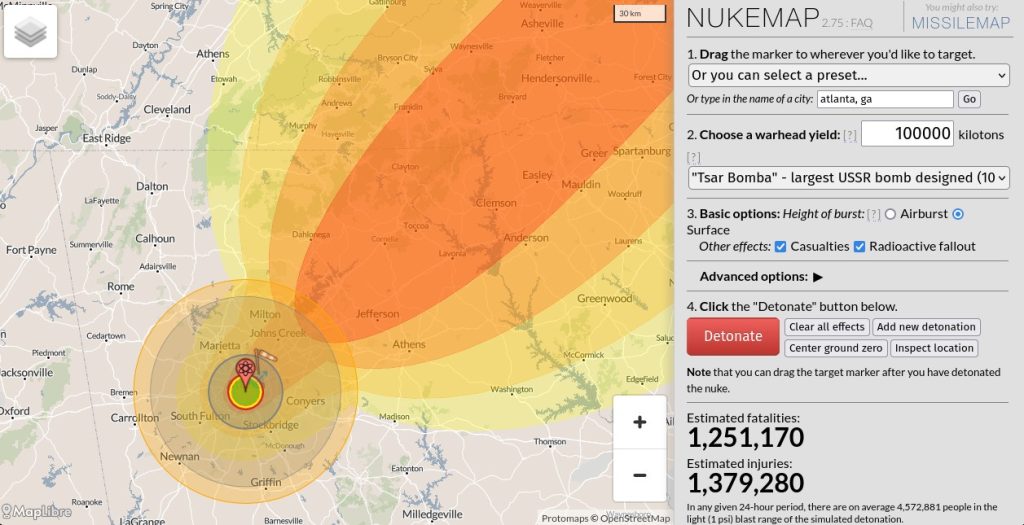Seems appropriate to post this again. I selected Atlanta as the detonation location and the largest bomb in the Russian arsenal. Evidently Atlanta is considered a target city because it’s a major transportation hub. Image below shows detonation and fallout given wind direction at the time I prepared the map. The previous map url map has been revised to the new one below.




Oh well. I really want to be close enough to become energy instantly. I sure as hell don’t want to hang around for a week or a month dying of radiation sickness.
4 hrs North of Atlanta is the little town of Oak Ridge TN. They might send one or two there.
I plan on facing North and waiting for the flash, the National Lab is about 25 min away.
Here is a nuke for you.
Klaus Schwab will own nothing: https://expose-news.com/2025/08/04/klaus-schwab-is-left-with-nothing/
Let’s hope he’s happy.
How the mighty have fallen!
Excellent news Matt x.
Here’s a few thoughts about the Atlanta strike shown.
The Tsar Bomba, the largest nuclear device ever detonated, was more of a demonstration project that was intended to cause fear in NATO countries than anything else. The device was so large that it was impractical for actual wartime use. There were serious questions about whether the plane that dropped it would make it out of the blast area. If memory served, modifications of the aircraft were necessary to even carry it.
Since the 1970s, the precision of targeting, for both conventional and nuclear weapons, has advanced greatly. Reliance on predicted fallout patterns from that time would be a serious mistake. The larger devices of the 1960s fell, essentially, in the “grenade” category. Today, smaller nuclear devices are used because of sniper-like precision. They can be counted on to actually hit the target by 100 yards, maybe 200 yards, and by even less than 100 feet (for US weapons).
For this reason, it is much more damaging to bomb a large target, such as a major metropolitan area, with multiple smaller devices than one large device. (For example, some have predicted that the LA area will get hit by as many as 22 nuclear devices.) For this reason, most nuclear devices fall within the 100 kiloton to 800-kiloton range. These are the typical warhead size weapons carried by a MIRV (Multiple Independently Targeted Re-entry Vehicle) missile.
The principle is the same as with conventional munitions. Multiple smaller detonations over an area can have a greater destructive effect than one larger detonation in the middle.
With smaller nuclear detonations, fallout patterns change. A smaller detonation does not send nuclear-contaminated debris/particles as high in the atmosphere. The fallout pattern is shorter. Crosswinds at different altitudes can change it, as well.
The most important thing to understand is that, unless there is some reason to use a ground burst (e.g., to take out an enemy missile silo or an underground command post) “more bang for the buck” is achieved in an urban area by using an airburst. This explains why we used airbursts on Hiroshima and Nagasaki. (Back to conventional munitions again, a conventional artillery shell’s detonation over the heads of troops in the open will be, in general, far more destructive than an artillery detonation on the ground whose destructive capacity is muffled.)
While there is LOCALIZED radiation from the bomb’s material in a nuclear airburst, there is no radioactively-contaminated soil and debris that will be sucked up high into the atmosphere to then flow downwind as fallout. While people living in the urban area will die in greater numbers from the heat and shock wave from the airbursts, those living downwind will be much safer.
Last of all, nuclear weapons must be serviced and maintained every so often to actually work. The US spent about 80% of the ENTIRE RUSSIAN MILITARY BUDGET (as of 2021) to maintain its nuclear weaponry. How much did the Russians spend? It is an open question about how many of Russia’s weapons sitting in silos will actually work after the passage of 30+ years since the Soviet Union fell.
The whole world saw during the invasion of Ukraine the effect of Russia’s neglect, corruption, and poor maintenance of its conventional military weaponry. Would we see the same results if its nuclear forces were ever used?
Very interesting and well said. Thank you for taking the time to write this. I chose the example to show what could happen, according to the creator of the map, not necessarily what would happen (okay, so I sensationalized it a little… guilty).
I also would like to believe that metropolitan areas would not be selected so much as military targets… I really believe that Russia (or China) is much smarter than that.
It’s likely that any retaliation against Russia, or China, would first be to obliterate their capacity to continue commerce of any kind… it would not be that difficult to wipe out China’s ability to use it’s ports for years to come. Russia doesn’t really have usable ports most of the year, so overland commerce would be targeted as well as their military. Given that, the likelihood of nuclear war is hopefully extremely low, although never zero.